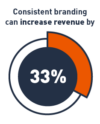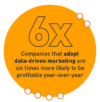Brand-to-Demand B2B Marketing: More than a Trend
If you work in business-to-business (B2B) marketing, you may have a mild case of whiplash. One minute, you’re building reputation with big brand investments and the next, you’re digging deep to drive pipeline and meet sales goals.
And with only 5% of buyers in the average B2B category ready to buy at any given time, it’s not surprising that more marketers are purposefully fusing brand building and demand creation efforts to balance the scales and ensure better control throughout major market shifts.
What Is Brand to Demand, Exactly?
Brand to demand is a marketing strategy focused on building brand awareness and recognition to generate demand for a product or service. Simply put, brand to demand is a multi-channel solution that leverages cohesive storytelling across integrated marketing and public relations campaigns to address the entire buyer journey.
While the approach may be a new one for some teams, the problems addressed by a brand-to-demand strategy are not new, nor are they going away. Demand generation tactics are always more impactful with a cohesive brand story behind them, and when the two are combined effectively, they serve as a solid foundation for teams to capitalize on emerging marketing trends.
The Power of Brand to Demand for B2B Companies
It’s the job of marketers to study the business and brand landscape and to build the most effective strategy for the moment. And while there’s always value in standing out from the crowd, there’s also something to be said for conventional wisdom. Brand to demand is a winning approach to age-old marketing challenges, and that’s not going unnoticed.
 According to a recent LinkedIn survey, more than half of marketers have reported wanting to run brand and demand campaigns simultaneously — and research by the Institute of Practitioners in Advertising supports them by showing that running brand and acquisition marketing together is six times more effective than running acquisition campaigns alone.
According to a recent LinkedIn survey, more than half of marketers have reported wanting to run brand and demand campaigns simultaneously — and research by the Institute of Practitioners in Advertising supports them by showing that running brand and acquisition marketing together is six times more effective than running acquisition campaigns alone.
Still, it wouldn’t be business without a problem. While 91% of marketers cite lead generation as their most important goal this year, just 53% of marketers spend at least 50% of their budget on lead generation. As a result, Chief Marketing Officers (CMOs) tasked to do more with less are challenged to bridge the gap between strategic plans and operational execution.
There’s a lot to consider, but when marketing teams can optimize their brand-to-demand approach while keeping their budget in mind, the return is worth the investment — especially since multi-channel marketing campaigns achieve a 31% lower cost per lead than single-channel outreach.
>> View the Full Infographic: The Brand to Demand Disconnect
The Optimal B2B Marketing Mix for Brand and Demand
The decision between brand and demand marketing has always come down to timelines — look to short-term performance marketing to show immediate return on investment (ROI) and sales, or invest in upper-funnel brand marketing to build awareness for long-term market prominence. As it turns out, brands can — and should — do both.
Just 5% of B2B buyers at any given moment are in the market for a purchase, but that doesn’t necessarily mean demand efforts are useless with the other 95% of prospects. Effectively integrating brand demand approaches starts with understanding that audiences are a bit more flexible than marketers tend to give them credit for. A prospect who is ready to buy can still appreciate brand story, while one in the earliest stages of the buyer journey won’t be ostracized by a demand tactic.
The goal, then, is to strike a balance between the two approaches, creating a customer experience that allows for seamless transition from brand to demand and back again. Some calculations suggest that for most B2B brands, an optimal breakdown allocates 54% of budget to demand and 46% to brand. But undoubtedly there will be some flexibility with the exact numbers. However, organizations that invest at least 50% of their budget in brand report seeing better overall financial performance.

As ever, the exact breakdown will be specific to the brand that executes it. The anecdotal recommendations of others will only take you so far, and ultimately marketers will do what they do best: strategize, execute, adjust, repeat. The good news is that brand to demand is a powerful approach that can drive significant results for B2B businesses of all sizes and industries.
>> Discover how a brand-to-demand approach can help you get listed in AI platform responses.
Brand to Demand: How It Works for B2B Marketing
With a well-executed brand-to-demand (B2D) strategy, your B2B company can create a brand that resonates with your audience while simultaneously driving demand for your products or services. Let’s take a look at the six key elements that make brand-to-demand marketing successful:
Key Element 1: Strong, Consistent Brand Identity
A strong, consistent brand identity is the backbone of any successful B2D strategy. It encompasses everything from your messaging to your visual identity, and is crucial in establishing authenticity, trust, and recognition with your audience.
Why Brand Identity Is Important
 A powerful and consistent brand identity not only differentiates your business from competitors but also cultivates trust and stimulates customer demand. As confirmed by a Lucidpress study, consistent branding can increase revenue by 33%. Pairing the right message and phrases with the right engaging creative design will attract and motivate stakeholders while providing a seamless, quality experience interacting with your brand that is recognizable and memorable.
A powerful and consistent brand identity not only differentiates your business from competitors but also cultivates trust and stimulates customer demand. As confirmed by a Lucidpress study, consistent branding can increase revenue by 33%. Pairing the right message and phrases with the right engaging creative design will attract and motivate stakeholders while providing a seamless, quality experience interacting with your brand that is recognizable and memorable.
How to Get Started
To create a consistent brand identity, start by defining your unique selling propositions and ensuring they align with your company’s values and mission. Develop brand guidelines along with a messaging and positioning framework that outlines your brand story and visual identity. Train your marketing and communication teams on these guides to ensure adherence, and include actionable resources, like brand filters, writing style guides or content checklists to empower your teams and ensure consistent application across your marketing and communications initiatives. Regularly review and update your guidelines to adapt to market trends and audience preferences.
Key Element 2: Audience Targeting and Segmentation
Audience targeting segmentation involves dividing a broad target market into subsets of customers based on shared characteristics. This approach allows you to personalize your marketing efforts and deliver more relevant messages to specific buying groups.
Why Audience Targeting Is Important 
Understanding and targeting specific audience segments allows you to create content and campaigns that resonate more deeply with potential customers. Research shows that revenue can soar by as much as 760% when companies utilize segmented campaigns compared to those that do not. This increased relevance can lead to higher-quality leads and improved conversion rates, making segmentation crucial for effective B2D marketing.
How to Get Started
Begin by conducting market research to understand your audience’s demographics, behaviors, and needs. Then, create ideal client profiles to guide your marketing strategy. Continually analyze your audience data to refine your targeting and segmentation strategies over time.
>> Related Read – Leveraging Data Strategically: A Q&A with Lauren Hill, PAN VP, Head of Data & Analytics
Key Element 3: Content Marketing and Storytelling
Content marketing and storytelling involve the creation and sharing of relevant, valuable content that engages your audience and drives them to action. This content can take various forms, including blog posts, whitepapers, videos, podcasts, and more.
Why Content and Storytelling Is Important
Gartner research reports that when B2B buyers are considering a purchase‚ they spend only 17% of that time meeting with potential suppliers. Independent online research plays a larger role than ever before, presenting both an opportunity and challenge for B2B marketers.
B2B buyers consume 3-5 pieces of content before initiating contact with a sales representative, reflecting the substantial role high-quality content plays in the decision-making process. Content not only draws and retains a specific audience but also inspires profitable customer behavior and distinguishes your brand as a thought leader in the industry.
 A strong narrative is a crucial component, as 49% of B2B executives are in search of content that tells a compelling story and deeply resonates with their purchasing committees. Storytelling has the power to foster emotional bonds with your audience, enhancing their engagement with your brand and content. Further, Gartner research found that customers who perceived the information they received from suppliers to be helpful in advancing across their buying jobs were 2.8 times more likely to experience a high degree of purchase ease, and three times more likely to buy a bigger deal with less regret.
A strong narrative is a crucial component, as 49% of B2B executives are in search of content that tells a compelling story and deeply resonates with their purchasing committees. Storytelling has the power to foster emotional bonds with your audience, enhancing their engagement with your brand and content. Further, Gartner research found that customers who perceived the information they received from suppliers to be helpful in advancing across their buying jobs were 2.8 times more likely to experience a high degree of purchase ease, and three times more likely to buy a bigger deal with less regret.
How to Get Started
To start creating high-quality content, define your content objectives, understand your audience’s needs, and craft content that is both engaging and valuable. Remember to optimize your content for search engines to increase visibility.
Key Element 4: Effective Multi-Channel Marketing
Multi-channel marketing involves interacting with customers across various platforms. This strategy can help reach your audience wherever they are most comfortable, improving their experience with your brand.
Why Multi-Channel Marketing Is Important
 In a report by Google & Boston Consulting Group, 80% of B2B buyers expect a business-to-consumer (B2C)-like experience, which often includes multiple touch points across channels. A study by McKinsey and Company found B2B companies that enabled purchase over more channels grew market share at a faster rate.
In a report by Google & Boston Consulting Group, 80% of B2B buyers expect a business-to-consumer (B2C)-like experience, which often includes multiple touch points across channels. A study by McKinsey and Company found B2B companies that enabled purchase over more channels grew market share at a faster rate.
Multi-channel marketing allows you to reach your customers where they are most comfortable, whether that’s on social media, email, or your website. By engaging your audience across multiple channels, you increase opportunities for conversions and enhance the overall customer experience.
How to Get Started
To develop a multi-channel marketing strategy, identify the platforms most used by your target audience. Then, create a consistent brand message across these platforms and set up analytics to measure the performance of each channel.
Key Element 5: Data-Driven Decision Making
Data-driven decision-making involves using quantitative and qualitative data to inform your marketing strategies. It helps you validate your approaches, understand your customers better, and track your marketing ROI.
Why Data-Driven Decision Making Is Important 
Companies that adopt data-driven marketing are six times more likely to be profitable year-over-year. Using data in your decision-making processes can lead to more effective marketing strategies, improved customer understanding, and better tracking of your marketing ROI. It ensures that your decisions are grounded in facts and evidence, rather than assumptions.
How to Get Started
To become more data-driven, start by identifying key performance indicators (KPIs) that align with your business goals. Use analytics tools to track these KPIs and integrate the insights you gain into your decision-making processes.
>> Related Read – Brand Awareness: Top Metrics and KPIs
Key Element 6: Lead Nurturing and Conversion
Lead nurturing and conversion involve guiding potential customers through the buying process, building relationships with them, and ultimately converting them into customers.
Why Lead Nurturing Is Important 
Effective lead nurturing and conversion strategies are crucial for turning prospects into customers. Forrester Research found that companies that excel at lead nurturing generate 50% more sales ready leads at 33% lower cost. They allow you to build stronger relationships with potential customers, enhance their experience with your brand, and ultimately boost your sales.
How to Get Started
Start by defining your sales funnel stages. Then, create a lead nurturing strategy that guides prospects through each stage, and monitor your conversion rates to assess the effectiveness of your strategy.
Future-Proof Your B2B Marketing Strategy with a B2D Approach
By mastering the key elements of B2D — strong brand identity, audience segmentation, content marketing, multi-channel marketing, data-driven decision making, and lead nurturing — you can create a brand that resonates with your audience and drives demand for your products or services.
>> Subscribe to our newsletter for more insights on how your B2B company can unlock the power of brand to drive demand now and for the future.
At PAN, we believe B2D is key to long-term B2B marketing success. Chances are, it’s what is missing from your mix. By merging brand and demand activities with PAN, you can conserve costs while reducing friction across your marketing mix.
>> Wondering if brand to demand is a good fit for your B2B business? Let’s talk.







